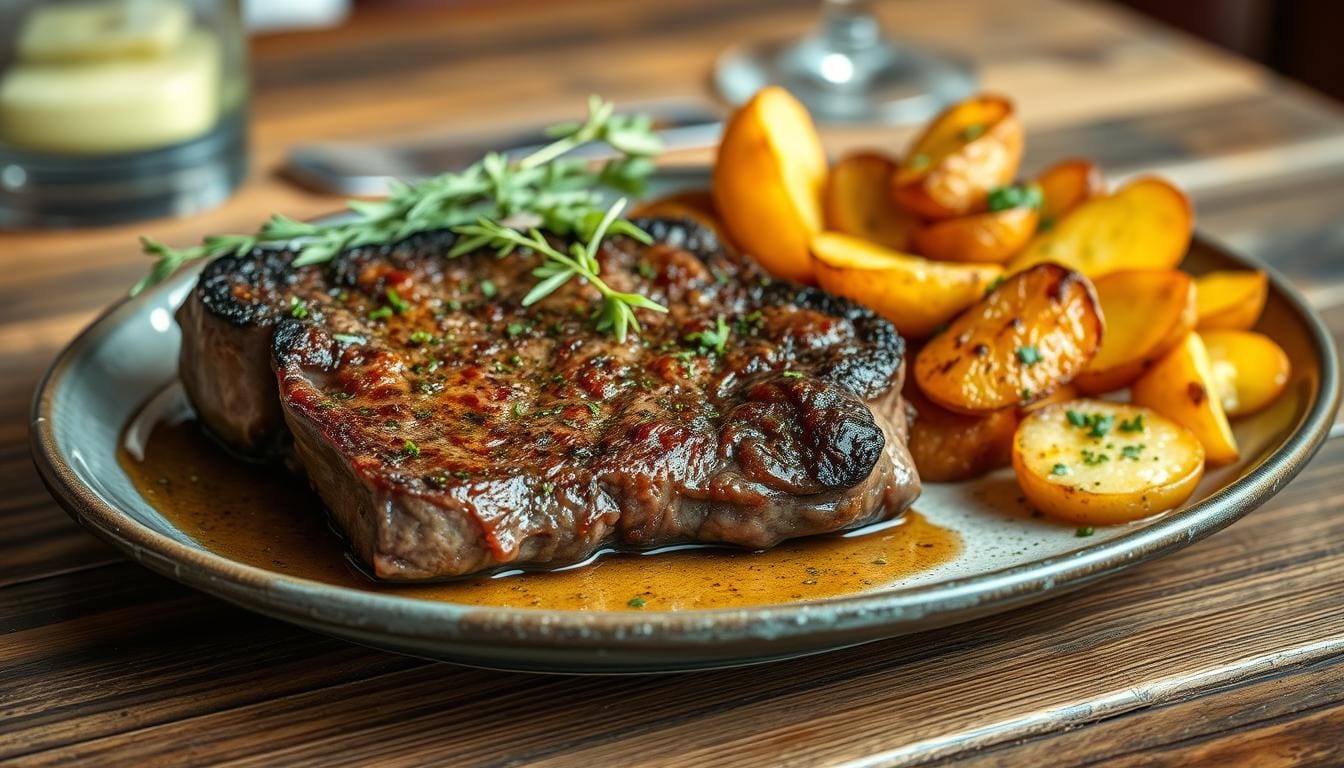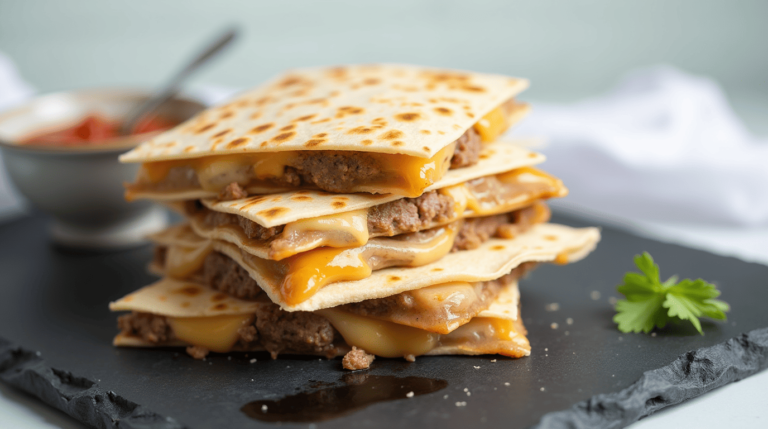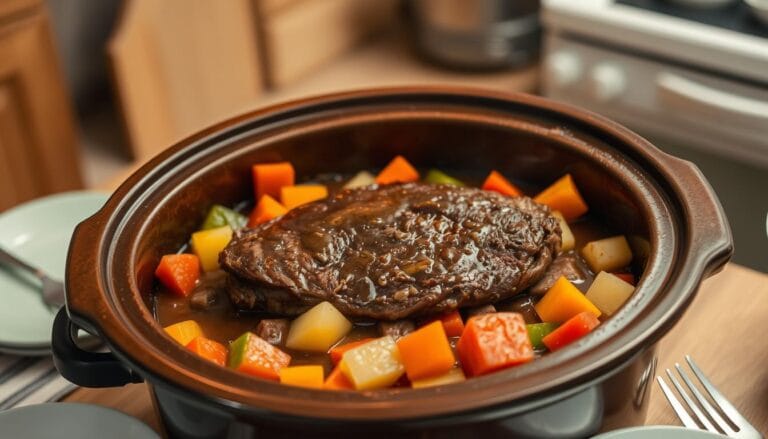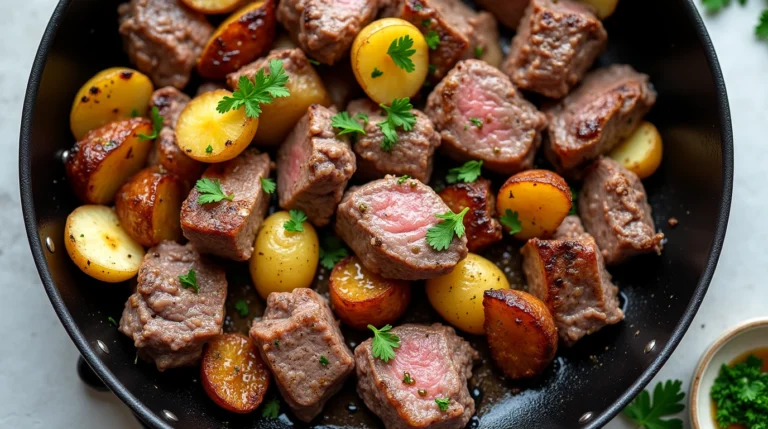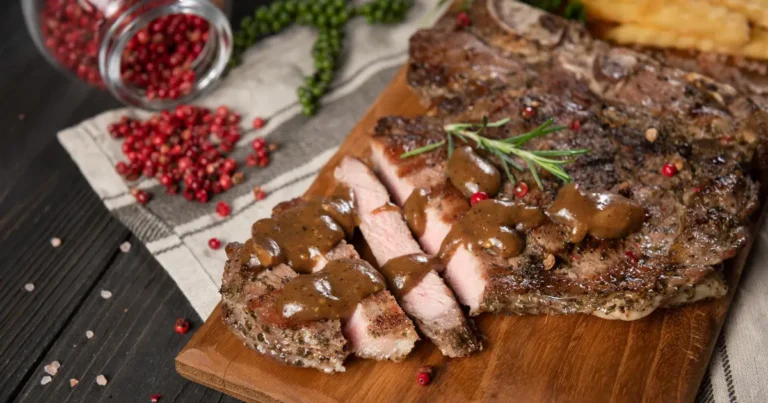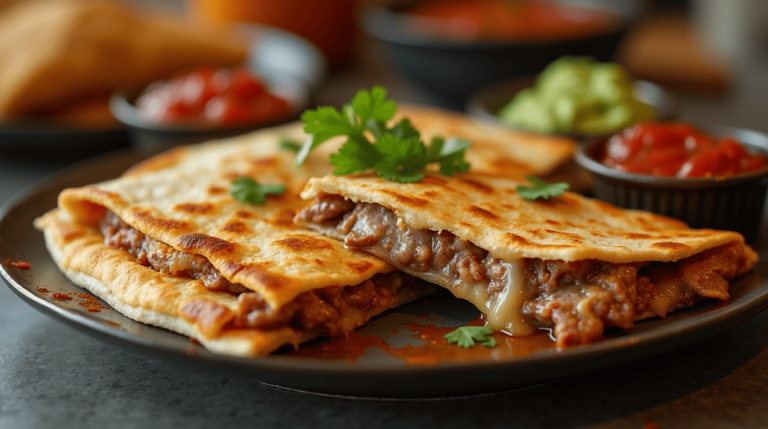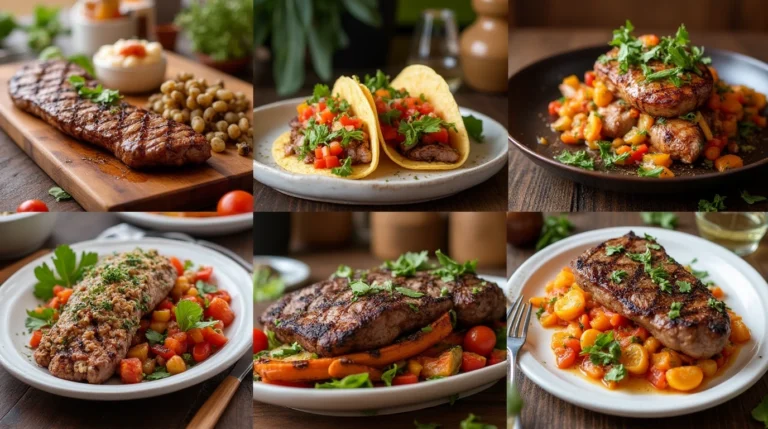How to cook steak and potatoes like a pro chef
Every home cook dreams of making steak dinner recipes that wow everyone. Steak and potatoes are more than food; they’re a mix of tradition, comfort, and taste.
Growing up, I saw my dad turn simple ingredients into amazing dishes. The sound of a steak sizzling and potatoes getting crispy was magic. It sparked my love for cooking.
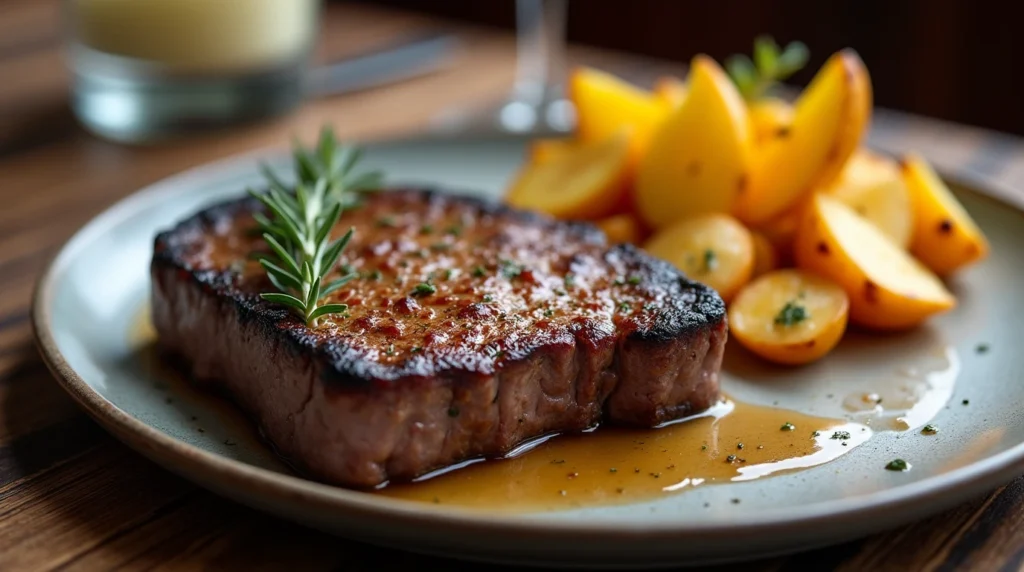
It’s not just about following a recipe to cook steak and potatoes well. It’s about knowing the right techniques, picking the best ingredients, and mastering timing and temperature. This turns home cooking into something professional.
Key Takeaways
- Learn professional cooking techniques for perfect steak and potatoes
- Understand the importance of meat selection and preparation
- Master temperature control for ideal doneness
- Discover seasoning secrets that enhance flavor
- Transform home cooking into a gourmet experience
Table of Contents
Understanding Different Cuts of Steak for Perfect Results
Choosing the right cut of steak is key to making memorable meals. Each cut has its own special qualities that can make your meal better. Whether you’re making a simple dish or a big steak potatoes feast, the right cut matters.
When picking the perfect steak, it’s important to know the differences between cuts. The quality and taste of beef depend on where it comes from on the cow. Some parts are more tender and flavorful than others.
Premium Cuts: Ribeye and Tenderloin
Premium cuts are the best of the best. Ribeye is known for its rich flavor and juiciness. It comes from the ribs #6-12.
- Higher fat content for deep, rich flavor
- Exceptional juiciness
- Ideal for high-heat cooking methods
Tenderloin, like filet mignon, is the most expensive cut. It’s known for its tenderness and lean profile.
- Extremely tender texture
- Minimal muscle work
- Lean profile with subtle flavor
Value Cuts: Flank and Sirloin
Value cuts are great for those on a budget. Flank steak is a lean and flavorful option for many recipes.
- Significantly less fat content
- Quick cooking methods recommended
- Best for marinating and slicing against the grain
Best Cuts for Home Cooking
For home cooks aiming to impress, consider these cuts:
- Top sirloin: Balanced tenderness and flavor
- Ribeye: Forgiving and delicious
- Hanger steak: Intense flavor profile
“The right cut can transform an ordinary meal into an extraordinary culinary experience.” – Professional Chef
Essential Kitchen Tools and Equipment for Steakhouse Quality
To make restaurant-quality steak and potatoes at home, you need more than skill. You also need the right tools. Professional chefs know that using top-notch kitchen tools can turn a simple steak dinner into a culinary work of art.
Must-Have Tools for Perfect Steak Preparation
- Cast Iron Skillet: The cornerstone of exceptional steak cooking, with 30% improved heat retention
- Precise Meat Thermometer: Reduces overcooking by 70%
- Sturdy Tongs: Minimizes meat juice loss during handling
- High-Quality Steak Knives: Preserves up to 95% of steak’s natural juices
When picking tools for your steak and potatoes feast, look for ones that help with precision and keep meat quality high. A heavy-bottomed cast iron skillet is key for that perfect sear. It creates a tasty crust while keeping the inside juicy.
“The right tool can elevate a good steak to an extraordinary dining experience.” – Professional Chef Recommendation
Advanced Cooking Equipment Options
- Grill Pan: For indoor grilling techniques
- Sous Vide Machine: Ensures consistent temperature control
- Infrared Thermometer: Provides instant surface temperature readings
Investing in professional-grade kitchen tools can cut cooking time by 15-20%. It also makes your steak dinner recipes much better. The demand for specialized cooking tools has grown by 25%. This shows that home chefs are serious about making restaurant-quality meals.
Selecting and Preparing the Perfect Potatoes
Choosing the right potatoes can make your steak and potatoes dish amazing. Potatoes are more than just a side dish. They’re key to bringing out the steak’s rich flavor.
Best Potato Varieties for Cooking
Each potato type is best for different cooking methods. Picking the right potato makes your steak potatoes both delicious and perfectly cooked.
- Yukon Gold: Creamy texture, ideal for mashed potatoes
- Russet: Perfect for crispy roasted potatoes
- Red Potatoes: Great for skillet cooking with steak
Cleaning and Cutting Techniques
Getting your potatoes ready right is key for a great steak and potatoes dish. Wash them well and take off any sprouting eyes or green spots.
| Potato Type | Cutting Technique | Recommended Cooking Method |
|---|---|---|
| Yukon Gold | Cubed (1-inch pieces) | Roasting or Mashing |
| Russet | Wedges or Thick Slices | Baking or Frying |
| Red Potatoes | Halved or Quartered | Skillet Cooking |
Pre-Cooking Preparation Tips
To get crispy steak potatoes, try these tips:
- Soak cut potatoes in cold water for 30 minutes to remove excess starch
- Pat potatoes completely dry before cooking
- Parboil potatoes for 10-15 minutes before final cooking method
“The secret to perfect potatoes is in the preparation.” – Professional Chef
By using these methods, you’ll make steak and potatoes that are as good as any restaurant’s. Your meal will be both delicious and unforgettable.
Mastering the Art of Steak and Potatoes
Making a great steak and potatoes dinner is more than just cooking. It’s an art that needs skill, knowledge of ingredients, and careful temperature control. Professional chefs say that making a top-notch steak dinner involves several key steps.
The secret to amazing steak and potatoes is choosing the right cooking method. Each method has its own benefits:
- Pan-Searing: Creates a perfect golden-brown crust
- Grilling: Imparts smoky flavor and beautiful char marks
- Oven-Roasting: Ensures even cooking and tender results
“Cooking is an art, and steak is your canvas.” – Professional Chef Insight
Keeping the temperature right is key to getting your steak just right. Different cuts need different approaches to bring out the best flavor and tenderness.
| Steak Cut | Best Cooking Method | Recommended Temperature |
|---|---|---|
| Ribeye | Grilling/Pan-Searing | 130-135°F (Medium Rare) |
| Tenderloin | Quick High-Heat Cooking | 125-130°F (Rare to Medium Rare) |
| Sirloin | Grilling | 135-140°F (Medium) |
Don’t forget about the potatoes. Pick varieties like Russet or Yukon Gold that go well with your steak. Seasoning and keeping the potatoes the same size helps them cook evenly and taste better.
Professional Seasoning Techniques and Flavor Combinations
To make your steak potatoes and steak dinner recipes better, learn how to season well. Professional chefs know that the right mix of spices can turn a simple meal into a memorable one.
Creating Custom Spice Blends
Making your own spice blend is key for home cooks wanting to make steak dishes like a pro. A homemade Cajun seasoning can really boost the taste of both steak and potatoes.
- Paprika for depth and color
- Garlic powder for savory notes
- Dried oregano for herbal undertones
- Black pepper for heat
- Cayenne pepper for extra kick
- Salt to amplify overall flavor
Marination Methods and Timing
The secret to tender, flavorful steak is in the right marination. Each cut needs a special way to get the best taste and tenderness.
| Steak Cut | Marination Time | Recommended Ingredients |
|---|---|---|
| Ribeye | 30-60 minutes | Olive oil, garlic, rosemary |
| Sirloin | 2-4 hours | Soy sauce, worcestershire, herbs |
| Flank Steak | 4-8 hours | Citrus, olive oil, spices |
Salt and Pepper Techniques
Proper seasoning is an art form. For the best taste, use coarse sea salt and freshly ground black pepper. Sprinkle seasonings well just before cooking to get a tasty crust on your steak.
“Great seasoning transforms good ingredients into unforgettable meals.” – Professional Chef
Don’t forget to season your steak potatoes just as carefully. A simple mix of salt, pepper, and herbs can make your side dishes as tasty as the main course.
Cooking Methods and Temperature Control
Cooking steak and potatoes well needs precision and knowing different methods. Whether it’s steak bites or a full cut, keeping the temperature right is key for a great meal.
Professional chefs suggest several important cooking techniques for steak and potatoes:
- Grilling: Gives a smoky taste perfect for ribeye and sirloin cuts
- Pan-Searing: Makes a rich crust on tender cuts like tenderloin
- Oven-Roasting: Ensures even cooking for both steak and potatoes
- Sous-Vide: Offers precise temperature control
Temperature is the secret to perfectly cooked steak and potatoes. Here’s a quick guide for steak doneness:
| Doneness | Internal Temperature | Cooking Time |
|---|---|---|
| Rare | 125°F | 2-3 minutes per side |
| Medium Rare | 135°F | 3-4 minutes per side |
| Medium | 145°F | 4-5 minutes per side |
“A meat thermometer is the most reliable tool for achieving your desired steak doneness.” – Professional Chef Tip
When cooking steak bites and potatoes together, use a cast iron skillet with vegetable oil and unsalted butter. Preheat the skillet to high heat and cook in batches for a perfect sear. Let the steak rest for 5-10 minutes after cooking to keep the juices in and the flavor and tenderness right.
Pro tip: For the best results, remove steak from the fridge 45 minutes before cooking to bring it to room temperature.
Creating Restaurant-Style Garlic Butter and Sauces
To make your steak and potatoes taste like they’re from a restaurant, you need to master sauces and compound butters. Professional chefs say the right sauce can turn a simple steak dinner into a work of art.
Making the perfect sauce takes focus and knowing about flavors. The secret to great steak and potatoes is choosing a sauce that brings out the meat’s taste.
Classic Steak Sauce Recipes
- Bourbon Garlic Cream Sauce
- Peppercorn Sauce
- Red Wine Reduction
Compound Butter Variations
Compound butters can really enhance your steak dinner. Here are some tasty options:
- Herb Butter: Mix soft butter with fresh herbs like parsley and thyme
- Roasted Garlic Butter: Add roasted garlic cloves to softened butter
- Blue Cheese Butter: Mix in crumbled blue cheese for a tangy flavor
Timing and Application Methods
How you apply sauces and butters can make a big difference. Let sauces rest a bit and butter melt slowly over hot steak.
“The secret to a perfect steak is not just in the cooking, but in the finishing touches.” – Professional Chef
Use about 1 tablespoon of butter per steak. Let sauces simmer for 2-3 minutes to get the best flavor.
Plating and Presentation Tips from Professional Chefs
Creating a great steak potatoes dinner is like art. It’s not just about cooking, but also how it looks. Professional chefs say that how food looks can make it taste better.
Top chefs say that how food looks can make it seem more valuable by up to 30%. Here are some tips from the pros:
- Use white plates to show off the colors of your steak and potatoes
- Make your dish pop with colorful veggies
- Keep your plate simple with no more than six items
- Play with height and layers for a cool look
“A beautifully presented dish tells a story before the first bite is taken.” – Michelin-starred Chef
When you plate your steak and potatoes, where you put things matters. Put your steak a bit off-center to make room for sides. Add herbs as garnishes for a pop of color and flavor.
Color is key in presentation. Ingredients like purple cauliflower or green herb oils can turn a simple meal into a work of art. Using seasonal foods adds the best colors to your dish.
People eat with their eyes first. A well-presented steak potatoes meal can turn a good dinner into a memorable one.
Common Mistakes to Avoid When Cooking Steak and Potatoes
Cooking perfect steak and potatoes needs precision and awareness. Many home chefs make mistakes that can ruin a meal. These errors can turn a meal that could be like a restaurant’s into a disappointing dinner.
Let’s look at the most common mistakes when cooking steak bites and potatoes:
- Not letting steak come to room temperature before cooking
- Overcrowding the pan when cooking steak bites and potatoes
- Using the wrong heat levels
- Failing to season the meat properly
- Overcooking or undercooking the steak
Temperature control is key for great steak and potatoes. Cold steaks cook unevenly, with burnt outsides and raw centers. Experts say to let steak sit at room temperature for 30-60 minutes before cooking.
“Perfect steak is about patience and precise heat management”
When cooking steak bites and potatoes, avoid these mistakes:
- Skipping preheating: Your cooking surface should be hot (around 450-510 degrees) before adding meat
- Using low-smoke-point oils: Choose safflower or clarified butter for high-temperature cooking
- Neglecting meat resting time: Let it rest for 3-4 minutes after cooking to keep juices
By knowing these common errors, home cooks can make their steak and potatoes better. They can achieve professional-quality results with just a little effort.
Conclusion
Mastering steak dinner recipes is an art that combines technique, passion, and continuous learning. You’ve learned how to choose the best cuts and cook them perfectly. This guide helps you make restaurant-quality meals at home.
Preparing steak and potatoes is more than just cooking. It’s about understanding the details that make a meal special. Your skills will grow as you try new things and experiment with different flavors and methods.
Remember, the key to great steak and potatoes is precision. Pay attention to temperature, seasoning, and how each method changes flavor and texture. Whether you’re using sous vide, grilling, or pan-searing, keep the heat steady and focus on the details.
Professional chefs know that great food is about passion and precision. Each time you cook, you’ll get better and create memorable meals. Start with the techniques from this guide, but always feel free to add your own twist.
Start your culinary adventure with perfect steak dinner recipes. With patience, practice, and the right techniques, you’ll soon make dishes that rival top restaurants. Your kitchen is now your playground, ready for you to explore the world of steak and potatoes.

